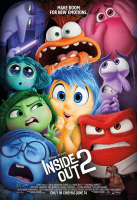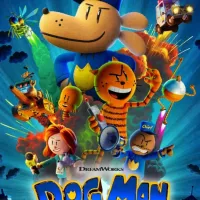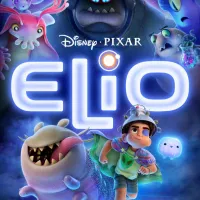
Inside Out 2
Inside Out 2
Pixar Animation Studios has long been a beacon of storytelling brilliance, and "Inside Out 2" is no exception. As a devoted fan of the original, my anticipation for the sequel was both high and cautious. Would it capture the magic of its predecessor or stumble under the weight of expectations? The answer is a resounding confirmation of Pixar's creative genius. From concept to execution, this film managed to elevate the original's unique premise to new emotional heights.
History and Evolution
The first "Inside Out" introduced us to the inner workings of a young girl's mind, brilliantly personifying her emotions. Its critical and commercial success set a high bar for any sequel. "Inside Out 2" faced the challenge of continuing a story that felt complete yet left room for further exploration. As Riley transitions into her teenage years, this sequel takes on the complexities of adolescence, a natural progression that feels both organic and deeply insightful. The history of these characters, with their well-established dynamics, allowed for a deeper emotional connection this time around.
The inherent allure of "Inside Out 2" lies in its unabashed exploration of puberty—a phase filled with emotional chaos. The addition of new emotions like Anxiety, Envy, Embarrassment, and Ennui (boredom) adds layers of relatability, making the movie resonate with both teenagers and those who remember their own tumultuous adolescence. Diverting from the typical animated sequel formula, "Inside Out 2" doesn't just rehash what worked before; it delves into the emotional spectrum with fresh perspectives and a more nuanced approach.
My Initial Impressions
I admit, watching the trailers didn't fill me with excitement initially. They hinted at humor that seemed a bit cringy, focusing on puberty jokes that felt low-hanging. However, influenced by my positive experiences with Pixar's past marketing strategies—which often underestimated their actual storytelling prowess—I decided to give it a shot. I'm truly glad I did. The movie immediately exceeded my tempered expectations, proving that Pixar’s magic goes far beyond what mere trailers can convey.
Character Development
One of the most significant improvements in "Inside Out 2" is its character development. Whereas the first film had a clear protagonist in Joy, the sequel spreads the narrative love. Joy's growth is evident; she’s more reflective and mature. Sadness, with her own side plot, continues to be a grounding force. What stood out most was how Anger, Fear, and Disgust, who were somewhat sidelined in the original, found more defined roles. They each get a fair share of the limelight, adding depth and relatability to their characters.
Fresh Faces
The introduction of the new emotions is handled masterfully. Anxiety takes center stage as the primary antagonist, although not in a stereotypical manner. She epitomizes the well-meaning yet overwhelming force that so many teenagers—and adults—battle with. Envy and Ennui, while not as prominent, complement Anxiety’s narrative, underscoring the interconnectedness of our feelings. Embarrassment, with surprisingly more involvement than anticipated, provides nuanced moments that highlight the awkwardness of adolescence.
Emotional Core
The emotional core of "Inside Out 2" is arguably stronger than the original. By focusing on the tumultuous period of adolescence, the film delves deeper into themes of identity, change, and acceptance. The narrative thread linking these emotions to Riley’s external world is seamless. It’s a poignant reminder that growing up is an emotional rollercoaster, one that’s portrayed with remarkable honesty and sensitivity.
Humor and Wit
Despite its heavier themes, "Inside Out 2" does not skimp on humor. The puns and clever wordplay are present, much to the delight of fans of the first movie. The balance between laughs and tears is one of Pixar’s strengths, keeping the audience engaged without feeling overwhelmed by the subject matter. Anger's new jokes and Fear's classic moments of hilarity are particular highlights that had the audience in stitches.
Visual Creativity
Visually, "Inside Out 2" is a feast for the eyes. Though it doesn’t explore as many new locations within the mind, the imaginative settings we do visit are meticulously crafted. From the vibrant landscapes of Riley’s mind to the abstract representations of her thoughts and feelings, every frame is a testament to Pixar’s unrivaled animation prowess. The visual storytelling complements the narrative perfectly, making for an immersive viewing experience.
Soundtrack and Sound Design
Music and sound design play a pivotal role in "Inside Out 2." Michael Giacchino returns with yet another beautiful score, enhancing the emotional beats of the movie. The sound effects, matched with the expressive voice work of the cast, add layers of depth to the characters and their world. Every emotion has its unique auditory signature, making the film an auditory delight as much as it is a visual one.
Lessons and Themes
The lessons and themes of "Inside Out 2" are poignant and relevant. The film handles the complexities of growing up with grace, emphasizing self-acceptance and the importance of acknowledging all our feelings. While Joy’s character arc might feel a bit mismatched at times, it ultimately ties in with the broader message of embracing change and understanding oneself. It’s a lesson not just for kids but adults as well, making it a universal story with broad appeal.
The Role of Riley
Riley’s role, though slightly reduced in terms of screen time within the physical world, is crucial to the film's success. Unlike the first film, where she often felt like a puppet to her emotions, Riley here is depicted as her own person. Her struggles and triumphs resonate deeply, aided by the emotions that subtly guide her decisions. The seamless blend of Riley’s outer world with her internal emotional landscape provides a robust narrative structure.
Balancing Act
With nine emotions now in the mix, the film had its work cut out in maintaining balance. Astonishingly, "Inside Out 2" manages this without making the narrative feel overcrowded. Each character gets their moment to shine, ensuring that the story remains cohesive and engaging. This balancing act is a testament to the film’s strong writing and direction, keeping the audience invested throughout.
Tiny Nitpicks
While the film is nearly flawless, a few tiny nitpicks do exist. Joy’s character arc, while compelling, sometimes felt slightly off pace. Also, the movie’s central lesson, though powerful, could have been supported more robustly in certain scenes. These are minor, however, and don't detract significantly from the overall experience.
Conclusion
In conclusion, "Inside Out 2" is a triumph of emotional storytelling, breathing fresh life into a beloved concept. Addressing the multifaceted nature of adolescence elevates its predecessor in both depth and resonance. The film's balance of humor, heart, and visual creativity reaffirms Pixar’s reputation for making animated features that appeal to all age groups. It reminds us that growing up is an emotional odyssey, one that’s beautifully chaotic and profoundly meaningful. For me, this film isn’t just a worthy sequel—it’s a new classic in its own right.
So, if you’re on the fence about watching "Inside Out 2," take my advice: do yourself a favor and see it. You’ll find yourself laughing, crying, and ultimately walking away with a fuller heart and a richer appreciation for the complexities of our emotions.

















